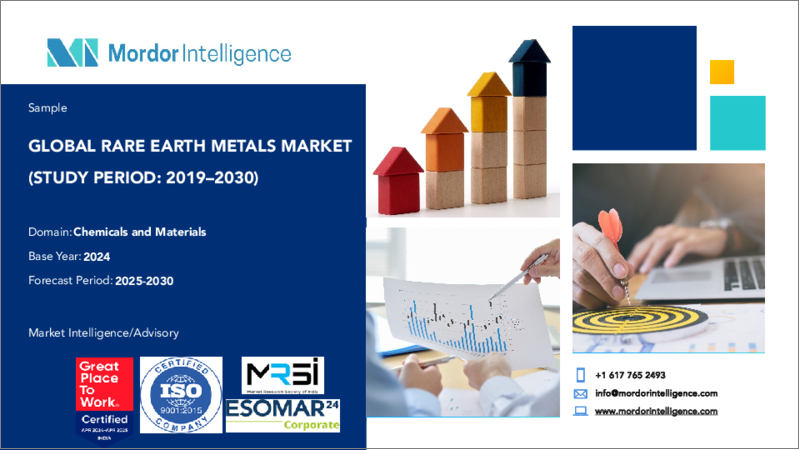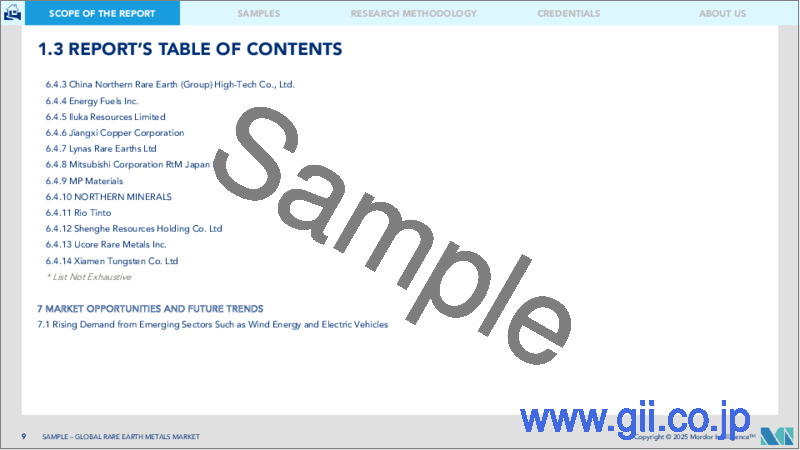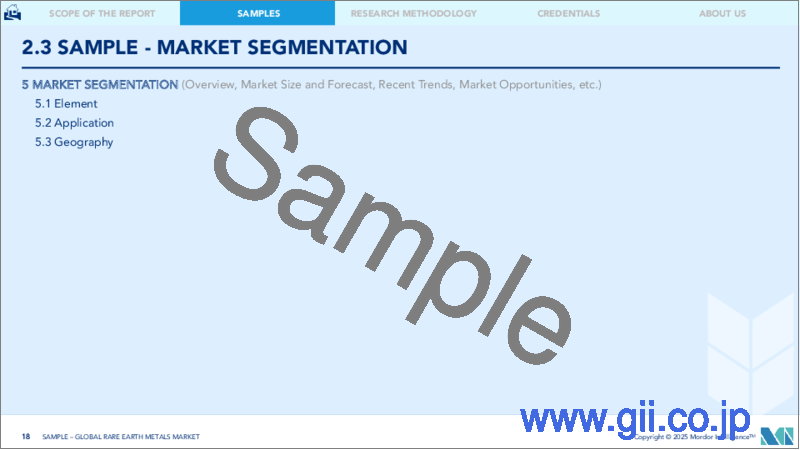|
|
市場調査レポート
商品コード
1685823
希土類元素:市場シェア分析、産業動向・統計、成長予測(2025年~2030年)Rare Earth Elements - Market Share Analysis, Industry Trends & Statistics, Growth Forecasts (2025 - 2030) |
||||||
カスタマイズ可能
適宜更新あり
|
|||||||
| 希土類元素:市場シェア分析、産業動向・統計、成長予測(2025年~2030年) |
|
出版日: 2025年03月18日
発行: Mordor Intelligence
ページ情報: 英文 150 Pages
納期: 2~3営業日
|
- 全表示
- 概要
- 目次
希土類元素の市場規模は2025年に182.36キロトンと推定され、予測期間(2025-2030年)のCAGRは4.19%で、2030年には223.91キロトンに達すると予測されています。

COVID-19は、長期にわたるロックダウンを受けて世界の需要が鈍化したため、希土類元素の需要にマイナスの影響を与えました。しかし、2021年には世界経済が復活し、産業活動が再開したため、状況は徐々に改善しました。
主なハイライト
- 市場成長の原動力となっているのは、新興国からの高い需要と「グリーンテクノロジー」への希土類元素依存です。
- その反面、希土類元素の供給が安定しないことが市場成長の障壁となる可能性があります。
- 航空宇宙用途でのスカンジウム使用量の増加は、予測期間中に市場に機会を提供する可能性が高いです。
- アジア太平洋地域は、希土類元素の生産量の増加と家電製品などの産業からの需要の増加により、世界市場を独占しています。
希土類元素の市場動向
磁石需要の増加
- 磁石は、希土類元素の最大の用途の1つです。磁石は、エレクトロニクス、自動車、発電、医療など、さまざまな産業で幅広く使用されています。
- 磁石は、コンピュータのハードドライブ、マイクロ波電力管、アンチロックブレーキ、自動車部品、ディスクドライブモーター、摩擦のないベアリング、発電、磁気冷凍、マイクとスピーカー、通信システム、MRIなどに使用されています。
- 自動車、エレクトロニクス、ヘルスケアなどの開発業界は革新と発展を目の当たりにしており、磁石の需要を牽引しています。
- 2021年には、約85%の自動車メーカーがネオジム入り永久磁石モーターを使用しており、2022年には希土類元素の自動車需要が25%増加するという予測もあります。
- EVや風力タービンに使用される磁石はネオジム、プラセオジム、ジスプロシウムであり、サマリウムやコバルトが代替品となる可能性があり、今後さらに市場を牽引する可能性があります。
- さらに、磁石はMRI装置、ペースメーカー、睡眠時無呼吸装置、インスリンポンプなどの医療機器にも使用されています。ヘルスケア業界では、アジア太平洋、中東・アフリカでかなりの投資が行われています。
- したがって、このような動向はすべて磁石の需要を促進すると予想され、今後数年間で希土類元素の需要がさらに増加すると予測されます。
アジア太平洋地域が市場を独占する見込み
- アジア太平洋地域が世界市場シェアを独占しています。ヘルスケア産業への投資が増加し、セラミックの需要と生産が増加していることから、この地域では希土類元素の消費が顕著に増加すると予測されています。
- これらの高価値希土類元素の世界供給のほとんどは中国に由来しており、世界の希土類元素市場の供給は中国の製造部門の変化に敏感になっています。米国地質調査所のデータによると、2021年、世界の希土類元素生産量の78%は中国産でした。
- OICAによると、2021年の中国とインドの自動車生産台数は、それぞれ2,608万台と439万台でした。従って、中国の自動車生産台数は前年比3%増、インドは30%増となりました。
- アジア太平洋は世界のエレクトロニクス生産拠点となっており、COVID-19の大流行によって中国とのサプライチェーンの問題が露呈したため、インド、ベトナム、日本といった国に拠点を構える複数の企業から投資が集まっています。
- 希土類元素のインド経済への貢献は、総額2,000億米ドル近くに上ります。インドの希土類元素埋蔵量は世界第5位で、オーストラリアの約2倍です。それでも、時折必要となる希土類元素の大半を、地政学上のライバルである中国から完成品として輸入しています。
- 日本は、希土類元素鉱物の備蓄を増やすことを期待しています。さらに、国内企業が海外の鉱山に出資し、原料を次世代自動車や通信機器などの最先端技術に必要な貴重な鉱物に加工するのを支援することも期待されています。UN Comtradeのデータによると、日本は10年以内に中国からの希土類元素輸入を90%以上から58%に削減しました。2025年までに50%以下にすることを目指しています。
- さらに、セラミックスの需要と生産はアジア太平洋で最も高いです。航空宇宙・防衛、エネルギー、ヘルスケア、消費財などの産業からのセラミック需要の増加が、この地域のセラミック生産を牽引しています。
- したがって、このような市場動向は、今後数年間、希土類元素市場に大きな影響を与えるでしょう。
希土類元素産業の概要
希土類元素市場は断片化されており、多数のプレーヤーが個々に市場力学に影響を与えるほど重要ではないシェアを保持しています。市場の著名なプレーヤーには、Lynas Rare Earths Ltd、Minmetals Land Limited、Aluminum Corporation of China Ltd、Iluka Resources Limited、Rare Element Resources Limitedなどがあります(順不同)。
その他の特典:
- エクセル形式の市場予測(ME)シート
- 3ヶ月間のアナリスト・サポート
目次
第1章 イントロダクション
- 調査の前提条件
- 調査範囲
第2章 調査手法
第3章 エグゼクティブサマリー
第4章 市場力学
- 促進要因
- 新興経済圏からの高い需要
- グリーンテクノロジーの希土類元素依存度
- 抑制要因
- 希土類元素の安定供給
- 産業バリューチェーン分析
- ポーターのファイブフォース分析
- 供給企業の交渉力
- 消費者の交渉力
- 新規参入業者の脅威
- 代替品の脅威
- 競合の程度
第5章 市場セグメンテーション
- 元素
- セリウム
- 酸化物
- 硫化物
- その他の元素
- ネオジム
- 合金
- ランタン
- 合金
- 酸化物
- その他の元素
- ジスプロシウム
- テルビウム
- イットリウム
- スカンジウム
- その他の元素
- セリウム
- 用途
- 触媒
- セラミックス
- 蛍光体
- ガラスおよび研磨
- 冶金
- 磁石
- その他の用途
- 地域
- アジア太平洋
- 中国
- インド
- 日本
- 韓国
- その他アジア太平洋地域
- 北米
- 米国
- カナダ
- メキシコ
- 欧州
- ドイツ
- 英国
- フランス
- イタリア
- その他欧州
- 南米
- ブラジル
- アルゼンチン
- その他南米
- 中東・アフリカ
- サウジアラビア
- 南アフリカ
- その他中東とアフリカ
- アジア太平洋
第6章 競合情勢
- M&A、合弁事業、提携、協定
- 市場ランキング分析
- 主要企業の戦略
- 企業プロファイル
- Aluminum Corporation of China Ltd
- ARAFURA RESOURCES
- Avalon Advanced Materials Inc.
- Minmetals Land Limited
- China Nonferrous Metal Industry's Foreign Engineering and Construction Co. Ltd
- Eutectix
- Iluka Resources Limited
- Lynas Rare Earths Ltd
- MEDALLION RESOURCES LTD
- NORTHERN MINERALS
- Peak Resources
- Rare Element Resources Ltd
- Rio Tinto
- Shin-Etsu Chemical Co. Ltd
- Ucore Rare Metals Inc.
- Xiamen Tungsten Co. Ltd
第7章 市場機会と今後の動向
- 航空宇宙用途でのスカンジウム使用の増加
The Rare Earth Elements Market size is estimated at 182.36 kilotons in 2025, and is expected to reach 223.91 kilotons by 2030, at a CAGR of 4.19% during the forecast period (2025-2030).

COVID-19 negatively impacted the demand for rare earth elements as the global demand witnessed a slowdown following stringent containment restrictions for a long time. However, the situation gradually improved in 2021 with the global economy's revival and industrial activities' resumption.
Key Highlights
- The factors driving the market's growth are the high demand from emerging economies and dependency on "Green Technology" on rare Earth elements.
- On the flip side, an inconsistent supply of rare earth elements may act as a barrier to the market's growth.
- The increasing scandium usage in aerospace applications will likely provide opportunities for the market during the forecast period.
- Asia-Pacific dominated the global market, owing to the increasing production of rare Earth metals and rising demand from industries such as consumer electronics.
Rare Earth Elements Market Trends
Increasing Demand for Magnets
- Magnets stand to be one of the largest applications for rare earth elements. Magnets find extensive applications in various industries, such as electronics, automotive, power generation, and medical.
- Magnets are used in computer hard drives, microwave power tubes, anti-lock brakes, automotive parts, disk drive motors, frictionless bearings, power generation, magnetic refrigeration, microphones and speakers, communication systems, and MRI.
- Industries such as automotive, electronics, and healthcare have witnessed innovation and development, driving the demand for magnets.
- In 2021, approximately 85% of automakers were using neodymium-incorporated permanent magnet motors, and there are projections that the automotive demand for rare earth will rise by 25% in 2022.
- Magnets used for EVs and wind turbines are neodymium, praseodymium, and dysprosium, with samarium and cobalt as potential substitutes, which may further drive the market in the future.
- Additionally, magnets are used in medical equipment, such as MRI machines, pacemakers, sleep apnea machines, and insulin pumps. The healthcare industry has seen considerable investments in Asia-Pacific, the Middle East, and Africa.
- Hence, all such trends are expected to drive the demand for magnets, which is further projected to increase the demand for rare earth elements in the coming years.
The Asia-Pacific Region is Expected to Dominate the Market
- The Asia-Pacific region dominated the global market share. With increasing investments in the healthcare industry and the rising ceramic demand and production, the consumption of rare earth elements is projected to increase noticeably in the region.
- Most of the world's supply of these high-value rare earth elements originates from China, making the global rare earth elements market supply sensitive to changes in China's manufacturing sector. In 2021, 78% of the worldwide production of rare earth elements came from China, as per data from the US Geological Survey.
- According to OICA, the total number of motor vehicles produced in 2021 in China and India was 26.08 million and 4.39 million units, respectively. Thus, motor vehicle production in China grew by 3% and 30% in India compared to the previous year.
- Asia Pacific has been the electronics production base of the world, with investments coming in from several companies establishing their presence in countries like India, Vietnam, and Japan, as the COVID-19 pandemic exposed the supply chain problems with China.
- Rare earth elements contribute a total value of nearly USD 200 billion to the Indian economy. India has the world's fifth-largest reserves of rare earth elements, roughly twice as much as Australia. Still, it imports most of its occasional Earth needs in finished form from its geopolitical rival, China.
- Japan is looking forward to increasing its stockpiles of rare earth minerals. Furthermore, the country is expected to help domestic companies to obtain stakes in overseas mines and to process raw materials into the valuable minerals required for next-generation vehicles, communications equipment, and other cutting-edge technologies. According to UN Comtrade data, Japan slashed rare earth supplies from China from over 90% of imports to 58% within a decade. It aims to bring that below 50% by 2025.
- Furthermore, the demand and production of ceramics are the highest in Asia-Pacific. The increasing ceramic demand from industries such as aerospace and defense, energy, healthcare, and consumer goods is driving the production of ceramics in the region.
- Hence, such market trends will significantly impact the rare Earth elements market in the coming years.
Rare Earth Elements Industry Overview
The rare Earth elements market is fragmented, with numerous players holding insignificant shares to affect the market dynamics individually. Some prominent players in the market include (not in any particular order) Lynas Rare Earths Ltd, Minmetals Land Limited, Aluminum Corporation of China Ltd, Iluka Resources Limited, and Rare Element Resources Limited, among others.
Additional Benefits:
- The market estimate (ME) sheet in Excel format
- 3 months of analyst support
TABLE OF CONTENTS
1 INTRODUCTION
- 1.1 Study Assumptions
- 1.2 Scope of the Study
2 RESEARCH METHODOLOGY
3 EXECUTIVE SUMMARY
4 MARKET DYNAMICS
- 4.1 Drivers
- 4.1.1 High Demand from Emerging Economies
- 4.1.2 Dependency of 'Green Technology' on Rare Earth Elements
- 4.2 Restraints
- 4.2.1 Inconsistent Supply of Rare Earth Elements
- 4.3 Industry Value Chain Analysis
- 4.4 Porter's Five Forces Analysis
- 4.4.1 Bargaining Power of Suppliers
- 4.4.2 Bargaining Power of Consumers
- 4.4.3 Threat of New Entrants
- 4.4.4 Threat of Substitute Products and Services
- 4.4.5 Degree of Competition
5 MARKET SEGMENTATION (Market Size in Volume)
- 5.1 Element
- 5.1.1 Cerium
- 5.1.1.1 Oxide
- 5.1.1.2 Sulfide
- 5.1.1.3 Other Elements
- 5.1.2 Neodymium
- 5.1.2.1 Alloy
- 5.1.3 Lanthanum
- 5.1.3.1 Alloy
- 5.1.3.2 Oxide
- 5.1.3.3 Other Elements
- 5.1.4 Dysprosium
- 5.1.5 Terbium
- 5.1.6 Yttrium
- 5.1.7 Scandium
- 5.1.8 Other Elements
- 5.1.1 Cerium
- 5.2 Application
- 5.2.1 Catalysts
- 5.2.2 Ceramics
- 5.2.3 Phosphors
- 5.2.4 Glass and Polishing
- 5.2.5 Metallurgy
- 5.2.6 Magnets
- 5.2.7 Other Applications
- 5.3 Geography
- 5.3.1 Asia-Pacific
- 5.3.1.1 China
- 5.3.1.2 India
- 5.3.1.3 Japan
- 5.3.1.4 South Korea
- 5.3.1.5 Rest of Asia-Pacific
- 5.3.2 North America
- 5.3.2.1 United States
- 5.3.2.2 Canada
- 5.3.2.3 Mexico
- 5.3.3 Europe
- 5.3.3.1 Germany
- 5.3.3.2 United Kingdom
- 5.3.3.3 France
- 5.3.3.4 Italy
- 5.3.3.5 Rest of Europe
- 5.3.4 South America
- 5.3.4.1 Brazil
- 5.3.4.2 Argentina
- 5.3.4.3 Rest of South America
- 5.3.5 Middle East and Africa
- 5.3.5.1 Saudi Arabia
- 5.3.5.2 South Africa
- 5.3.5.3 Rest of Middle East and Africa
- 5.3.1 Asia-Pacific
6 COMPETITIVE LANDSCAPE
- 6.1 Mergers and Acquisitions, Joint Ventures, Collaborations, and Agreements
- 6.2 Market Ranking Analysis
- 6.3 Strategies Adopted by Leading Players
- 6.4 Company Profiles
- 6.4.1 Aluminum Corporation of China Ltd
- 6.4.2 ARAFURA RESOURCES
- 6.4.3 Avalon Advanced Materials Inc.
- 6.4.4 Minmetals Land Limited
- 6.4.5 China Nonferrous Metal Industry's Foreign Engineering and Construction Co. Ltd
- 6.4.6 Eutectix
- 6.4.7 Iluka Resources Limited
- 6.4.8 Lynas Rare Earths Ltd
- 6.4.9 MEDALLION RESOURCES LTD
- 6.4.10 NORTHERN MINERALS
- 6.4.11 Peak Resources
- 6.4.12 Rare Element Resources Ltd
- 6.4.13 Rio Tinto
- 6.4.14 Shin-Etsu Chemical Co. Ltd
- 6.4.15 Ucore Rare Metals Inc.
- 6.4.16 Xiamen Tungsten Co. Ltd
7 MARKET OPPORTUNITIES AND FUTURE TRENDS
- 7.1 Increasing Scandium Usage in Aerospace Applications






